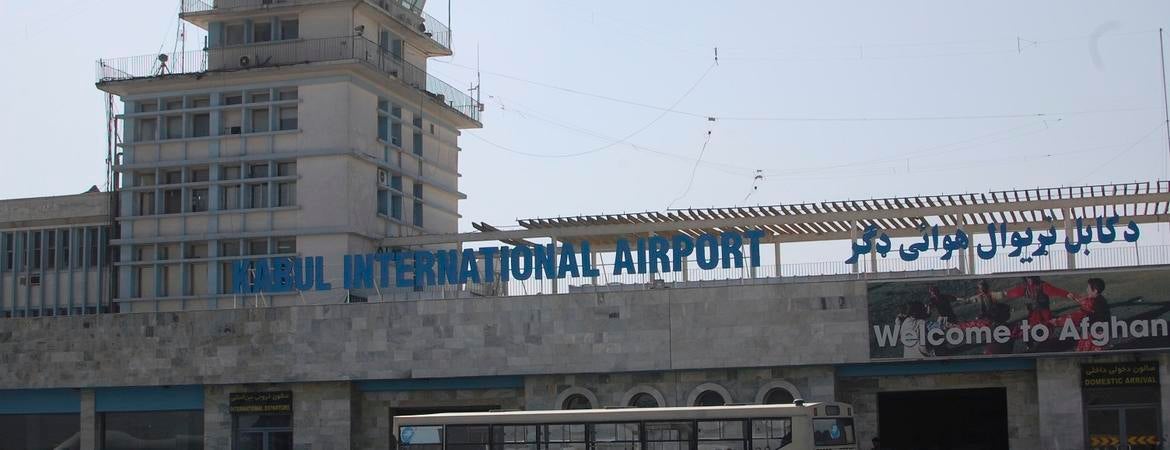
For students of history and those old enough to remember, the rapidity with which the Taliban captured the Afghan capital of Kabul evoked memories of the April 1975 fall of Saigon, the South Vietnamese capital.
The 20-year American presence in Afghanistan ended this week with the mass evacuation of 120,000 Americans and Afghan citizens in only 17 days. Similarly, the capture of Saigon was preceded by the evacuation of almost all American civilian and military personnel in Saigon, along with tens of thousands of South Vietnamese civilians who had been associated with the Republic of Vietnam.
We asked UC Riverside history professor, award-winning author, and Vietnam scholar David Biggs to reflect on the recent, troubled exodus from Kabul, and what lessons Vietnam may hold for post-occupation Afghanistan. Biggs’ most recent book is 2018’s “Footprints of War: Militarized Landscapes in Vietnam.” A free, downloadable, open-access version of the book is also available.
Is it accurate to compare the fall of Kabul to the Taliban in Afghanistan to the fall of Saigon in Vietnam?
The images of helicopters over Kabul remind us of similar scenes from Saigon in 1975, but that is about where the similarities end. North Vietnam’s People’s Army closed Saigon’s airport by bombing it while thousands of communist troops with several hundred tanks made a violent advance on the city.

South Vietnam’s pilots flew the country’s fighter and cargo planes to Thailand while helicopter pilots flew out to sea and made emergency landings on U.S. Navy ships. The evacuation from Saigon marked a violent and chaotic end to one of history’s most violent wars. Despite recent violence from ISIS-K extremists, the evacuation from Kabul did not approach the same level of violence or chaos.
Some historians characterize Operation Frequent Wind — the evacuation of Americans and South Vietnamese loyal to Americans from Saigon — as successful, given its large scale. Others said the airlift was too slow, and didn’t remove enough Vietnamese citizens connected to Americans. How does the evacuation in Afghanistan so far compare, and how is it likely to be viewed by history?
With Operation Frequent Wind, there were some high-ranking officials who opposed evacuating Vietnamese nationals; then there were others who ultimately prevailed and succeeded in getting approval from President Ford to accept more refugees. We know from declassified documents that CIA, military, and State Department officials argued for weeks about how many Vietnamese refugees to accept, and I imagine in 30 years, we’ll find the same thing happened in Kabul. As I understand it, more than 100,000 Afghan refugees were evacuated by the U.S. before the last plane departed Kabul, so the figures are about equal.
Did the North Vietnamese contend with radical factions while asserting its rule of Saigon (renamed Ho Chi Minh City) after the war?
We know very little about internal Communist Party factionalism in Vietnam after 1975, but the general view is that the winning side remained remarkably centralized after reunification due in large part to the communists’ success in promoting political and military talent from southern provinces. This began with early party activists and continued into the 1980s with the reform-minded prime minister, Vo Van Kiet, who advanced liberalization reforms.
What can the Taliban and the people of Afghanistan learn from Vietnam’s postwar history?
For the new state in Afghanistan, the challenges have just begun and there are important lessons from Vietnam’s postwar history. The first 16 years, 1975-91, were dark. The new Vietnamese state imprisoned almost any people who had ties, any ties, to the old government. Immediately after the war, the new government was quick to identify and imprison some 100,000 former government and South Vietnamese military fighters. They called these camps reeducation camps, and families of former regime officials and soldiers faced a sort of black-listing that prevented them from entering colleges and taking certain jobs. Those polices lasted for more than 20 years after the fall of Saigon. In the decade after Saigon’s fall, a million more people fled Vietnam by foot or by boats and about a quarter to a half of them died at sea. Vietnam’s economy plummeted into a devastating economic depression as it tried to rebuild shattered infrastructure, re-green defoliated forests, and replace aging industries.
But Vietnam’s recent postwar history may offer more hopeful lessons. The 30 years since 1991 have been, in contrast to the early period, like an almost-Hollywood ending to a century of colonialism and war. I think there may be lessons there for the Taliban. This turnaround in Vietnam has been based on reestablishing ties with the West, allowing people to migrate, and allowing more liberal reforms. If Afghanistan’s government can somehow leapfrog its immediate economic and political troubles into this more worldly, friendly, and liberal future, then maybe there is hope for a kind of Vietnam-like ending.
I think the news of direct talks between senior American and Taliban officials signals that neither side, the U.S. or Afghanistan’s new government, want to repeat the diplomatic isolation that followed the fall of Saigon. It will be especially interesting to witness what happens in Kabul, for Kabul like Saigon seems to symbolize the promise of a more liberal Afghanistan.
“If Afghanistan’s government can somehow leapfrog its immediate economic and political troubles into this more worldly, friendly, and liberal future, then maybe there is hope for a kind of Vietnam-like ending.”
Afghanistan’s new rulers may also emulate the Vietnamese government’s policy on overseas diasporas. For years, overseas Vietnamese were treated as suspects or “traitors” by the communist government in Vietnam, but as the government relaxed rules on remittances — the funds overseas immigrants send to family back home — they witnessed an incredible influx of foreign currency and investment. Remittances were a trickle in 1990, $21 million, but now they top $15 billion with almost half of the funds going to Ho Chi Minh City. I think Taliban economists are very much aware of Vietnam’s case, and I hope that the government will allow Afghans to migrate overseas with the knowledge that this overseas diaspora will eventually be an important driver for economic growth.
What was key to Vietnam normalizing economic relations with the West, and what are some first steps for Afghanistan/the Taliban?
For Vietnam, the biggest key was the Soviet Union’s collapse. The U.S. maintained its trade embargo on Vietnam until 1994, choking off much-needed Western currency. Vietnamese leaders repeatedly attempted to normalize ties after 1975, even welcoming American banks and oil companies to talks, but the Cold War prevented a fast normalization as Soviet advisors and military units moved into Vietnam after 1975. Vietnam’s Renovation Policy in 1986 followed reforms in the Soviet Union called perestroika (reconstruction), so that was the beginning of talks; then things began to proceed more quickly with the collapse of the Warsaw Pact in 1989 and finally the collapse of the Soviet Union.
“The competitive presence of other powers — China, Russia, Pakistan, the Emirates, India, and the U.S. — means that we may see the possibility for a quicker reconciliation process between Afghanistan’s new government and the international community.”
The world today, especially in the Middle East, is very different geopolitically, and I think the competitive presence of other powers — China, Russia, Pakistan, the Emirates, India, and the U.S. — means that we may see the possibility for a quicker reconciliation process between Afghanistan’s new government and the international community.
It’s likely the authoritarian, fundamentalist Taliban regime will continue to rule Afghanistan. Is single-party, authoritarian rule incongruous with economic prosperity?
Vietnam’s rebound didn’t mean ending single-party rule. Vietnam remains a single-party state, and while there are continuing complaints about repression of free speech and imprisonment of dissidents, the Party is the major force in Vietnam. However, Vietnam’s Party has become less hardline in its ideology, like China, and it has made many concessions with economic reforms and also greater freedoms for religious organizations and a more cosmopolitan social environment. Vietnam has rebranded itself as a “friendly” nation for tourism and regional diplomacy.
Also, a common refrain heard by people on the street in Vietnam is this: “Which form of Southeast Asian democracy is preferable to our government? Thailand? Philippines? Indonesia?” So long as the country’s economy is booming and people are better off than in the “dark days” after 1975, I don’t see much significant interest in democratization.
So, one-party rule doesn’t preclude economic stability. But does it preclude social justice reform?
I think that’s the case the world over, but then multiparty states have their problems, too. We read about the detention of journalists in EU countries that have multiple parties. Countries like Poland and Hungary have passed anti-LGBTQ laws, and in Southeast Asia, the rule of Rodrigo Duterte in the multiparty Philippines has coincided with thousands of extrajudicial killings by police and paramilitaries. Vietnam by contrast has legalized gay marriage, and it is one of the safest countries in the world with a murder/homicide rate just one-fifth that of the United States.
Is the Taliban’s pledge not to prosecute former enemies a good step in this direction? Does history provide good reason to be skeptical of such a pledge?
I hope so, but I think there is a strong tendency for victorious governments to identify those who worked with former governments and at least discover whether those individuals were responsible for any perceived crimes, like corruption or police killings, and to prosecute them. There are international laws for processing prisoners of war (especially those who surrender), and I think the big issue for the Taliban today is whether they can effect an orderly, legal and nonarbitrary means to address these issues with individuals in the former regime. I know of no cases where victor governments didn’t proceed with some form of war crimes trials.
Did we “lose” the war in Vietnam and is it fair to brand the American effort a failure? Did we fail in our mission in Afghanistan?
That’s a tough question. The U.S. failed in its mission (in Vietnam) to contain communism and prop up a noncommunist regime, and I would brand any campaign that cost 50,000 American lives and more than 4 million Vietnamese lives a failure in humanitarian, economic, and political terms. Some would say the Vietnam War wasn’t ours to lose. American forces stepped in first to support a French-backed government in 1950 and then sent forces in 1965. But at its heart, the war in Vietnam was a war between Vietnamese people. That may be hard to grasp given the overwhelming technological presence of American (and other foreign) forces, but everyone knew the foreign troops would eventually leave and all that would be left were Vietnamese combatants and their families to pick up the pieces amid the ruins.
“In the long run, those ties that Americans formed with Afghans may ultimately prove most useful in helping achieve lasting peace.”
I think what is remarkable about the United States’ presence in South Vietnam, and possibly in Afghanistan, was what happened off the battlefield — the commitment to improving civilian life through public works projects, building schools and hospitals, and generally exposing large numbers of people to everyday American life. To the extent that leaders were not corrupt and military actions didn’t destroy that civilian infrastructure, those contributions and people-to-people ties went a long way towards effecting positive, nonviolent change in Vietnam. I guess a similar thing might happen in Afghanistan.
I’m a skeptic about the effectiveness of American military power to achieve peace, but I’m extremely optimistic about the generosity and compassion of the American people. I think in the long run, those ties that Americans formed with Afghans may ultimately prove most useful in helping achieve lasting peace.
Header photo by Jim Kelly, Flickr Commons



